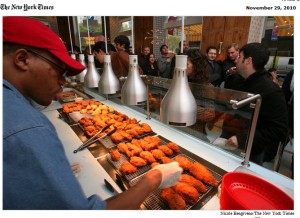
Ingles, a successful regional grocery store chain headquartered in Black Mountain, NC, uses the tagline “LOW Prices…LOVE the savings.” Let’s take a look at the tagline for branding value.
First, it breaks a cardinal rule. Let’s call it the “Tastes Great! Less filling!” rule. Good brand strategy is about a single claim. Now all rules are made to be broken but I choose to keep this one sacrosanct. (That said, if I can get a double meaning out of a word choice, no harm no foul.)
Second, “LOW prices,” all caps or not, is not a particularly aspirational claim. Low prices, suggests low quality. That’s not Ingle’s fault it’s the marketing world’s fault. Does your mouth water over a dollar slice of pizza? Does the Dollar Store bring to mind, clean floors, welcoming clerks, and fully stocked shelves?
Third, “LOVE the savings” is redundant. Saying it twice doesn’t make it so. It only reinforces point number two, reminding you every time you come upon an over ripe piece of produce.
Fourth, “LOVE the savings” tells the consumer how to feel. Not a cardinal rule but most people already have mom. It’s presumptuous. Don’t tell consumers how to feel. make them feel. Use a unique claim and carefully curated proof planks.
Ingles is a family business, it’s nearby, the stores are nearly immaculate, and they are brightly lit! There’s a lot to work with for a well-honed brand claim. Defaulting to Aldi’s positioning (who really has proof(s) of price advantage) is lackluster, off-piste brand craft.
Peace.










